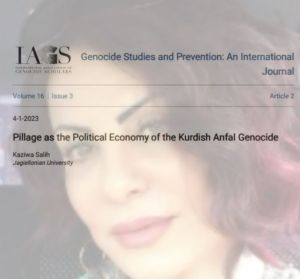Pillage as the Political Economy of the Kurdish Anfal Genocide
Kaziwa Salih, Jagiellonian University
Abstract Scholars are critical of how economists overlook “the questions of genocide,” and of how legislatures have not paid adequate attention to the subject of looting, except in the case of the Armenian genocide. This article, informed by interdisciplinary perspectives, uses government documents, data, and semi-structured interviews to discuss the overlooked triangle of looting, economics, and the Anfal genocide of the Kurds in Iraq. The study refuses to limit itself only to the eight stages of the Anfal genocide that started in 1988, and instead offers data on its preliminary phases which occurred earlier in the 1980s. It then discusses the multidimensional political economy of the Anfal genocide and argues that (a) the legalized plundering of spoils of war by the Ba’ath regime served as a political economic strategy to justify the Anfal genocide; (b) Saddam Hussein utilized economic prospect theory—putting a higher emphasis on imagined gains than on losses—by maximizing revenue and minimizing the cost of the genocide; and (c) Saddam’s use of symbolic religious names and Qur’an verses did not demonstrate his religious commitment, but rather aimed to foster and restore the cultural legacy of looting among ordinary people. The article focuses on rewards, in the form of economic capital earned from looting and confiscations, as goals that aided the effective execution of the Anfal genocide and promoted divisions within urban Kurdish society but that failed to deracinate Kurdish resistance culture.
To read or download click the blue link
